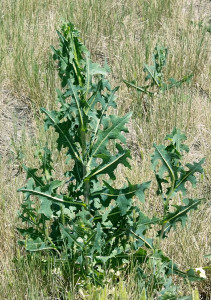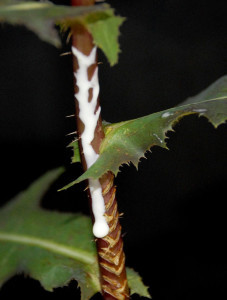The Canadian government used to create Crown Corporations, a kind of quasi-government agency/ business corporation that was run as a not-for-profit operation. Sustainable Development Technology Canada (SDTC) bears some of the marks of a crown corporation (completely government-funded) but it’s self-described as a not-for-profit foundation. Before getting to the main event (Vive Crop) here’s a little bit from the SDTC Profile page,
Sustainable Development Technology Canada (SDTC) is a not-for-profit foundation that finances and supports the development and demonstration of clean technologies which provide solutions to issues of climate change, clean air, water quality and soil, and which deliver economic, environmental and health benefits to Canadians.
SDTC operates two funds aimed at the development and demonstration of innovative technological solutions. The SD Tech Fund™ supports projects that address climate change, air quality, clean water, and clean soil. The NextGen Biofuels Fund™ supports the establishment of first-of-kind large demonstration-scale facilities for the production of next-generation renewable fuels.
SDTC is clearly focused on the economy and entrepreneurship in addition to sustainability as per their Sept. 9, 2013 news release about a recent $14.7M investment,
The Government of Canada is showing its commitment to a green Canadian economy with an in investment of $14.7 million to help four new clean technology projects from across the country reach commercialization. The announcement was made today by the Honourable Joe Oliver, Minister of Natural Resources, and Dr. Vicky Sharpe, President and CEO of Sustainable Development Technology Canada (SDTC).
“Canada must nurture highly skilled individuals and new ideas that will help our businesses innovate, secure new markets and create well-paying jobs,” said Minister Oliver. “By supporting advanced research and technology, our government is investing in Canadian prosperity and a cleaner environment.”
“The projects announced today are great examples of the Canadian innovation and entrepreneurship that characterizes SDTC’s portfolio, valued at more than $2 billion and brimming with innovative technological solutions,” said Vicky Sharpe, President and CEO of SDTC. “Canadian cleantech leaders are continuing to create economic opportunities and open up avenues to new export markets.”
…
The newly-funded projects are representative of the investment priorities established in the SD Business Cases™, a series of six reports published by SDTC that provide strategic insights into specific economic sectors (available in the Knowledge Centre section of the SDTC website at http://www.sdtc.ca/).
SDTC’s SD Tech Fund™ has committed $598 million to 246 clean technology projects. These figures include adjustments made to the portfolio.
Vive Crop, headquartered in Toronto, Ontario, is a recipient for two of the four projects being funded. Here’s more about one of the projects from the Sept. 18, 2013 Vive Crop news release,
Vive Crop Protection is pleased to announce that it received an investment of $3.7 million from the Government of Canada through Sustainable Development Technology Canada (SDTC) to develop an improved pesticide application distribution method that will translate into greater efficiency and reduced wastage.
Vive’s Allosperse® particle will be used to hold pesticides and deliver them precisely where they need to go.
“Canada must nurture highly skilled individuals and new ideas that will help our businesses innovate, secure new markets and create well-paying jobs,” said Minister Oliver. “By supporting advanced research and technology, our government is investing in Canadian prosperity and a cleaner environment.”
…
“Canadian farmers want a more economical and effective way to protect their crops from pests,” said Keith Thomas, CEO, Vive Crop Protection. “Thanks to support from the Government of Canada through Sustainable Development Technology Canada, Vive Crop Protection will further develop the Allosperse platform, precisely targeting pesticides where they act on crops.”
The best crop protection happens when pesticides stay where they are intended to protect the crop, for example on a crop’s leaves or at its roots. Vive has developed Allosperse®, a tiny particle that has unique properties: it has a hydrophilic (water-loving) exterior and an oleophillic (oil-loving) interior. Pesticides, which are also oleophillic, are loaded into the particle before application to crops. The next generation of Allosperse particles will have increased stickiness to leaves, avoiding run-off during the rain, and will penetrate leaves and seeds to offer systemic plant protection. Finally, the specially-designed particles will control the movement of the particle through the soil, allowing it to target pests at the plant’s roots. Less product, and therefore less cost, would be required to achieve equivalent results, and growers can get better protection with less accidental surface water run-off and soil contamination.
I have written about Vive Crop previously (most recently in an Aug. 7, 2013 posting when they received approval from the US Environmental Protection Agency for an insecticide) and my curiosity about Allosperse particles has not yet been satisfied. What are the chemical constituents? In lieu of an answer to that question (it’s nowhere on the company website), I found more information about Vive Crop and its SDTC-funded projects in this latest round of funding. As I noted previously, Vive Crop is involved in two of the funded projects as per the Sept. 9, 2013 SDTC backgrounder,
2. Lead organization: Macrotek
Project Title: Novel MVI Acid Gas Scrubbing Technology Project
Environmental Benefits: Climate Change/Clean Air/Clean Water/Clean Soil
Economic Sector: Waste management
SDTC Investment: $2 million
Consortium Members:
Macrotek
Vive Crop Protection [emphasis mine]
Plasco Energy Group
Project Description:
To avoid injecting contaminants into the atmosphere, industries use chemical reactions to “scrub” exhaust before it is emitted from smokestacks. However, current scrubbing techniques use caustic and oxidizing reagents (materials used to produce a chemical reaction). Macrotek has developed a groundbreaking suite of technologies that scrub in a novel, cost-effective and efficient way. The technology is developed initially to eliminate hydrogen sulfide (H2S), which is a major component of acid rain, from industrial gas streams. The technology uses a regenerative reagent, drastically reducing reagent consumption. It also converts H2S into its elemental form of sulphur, eliminating the current need to treat sulphate byproduct in wastewater streams. When full life-cycle costs are considered, this technology could cost less than 50 percent of the operating costs of traditional scrubber technologies, while maintaining or improving contaminant removal efficiency. This technology has the potential to address a multitude of other pollutants, such as nitrogen oxides, simultaneously.
3. Lead organization: Vive Crop Protection
Project Title: Targeted Delivery for Crop Protection
Environmental Benefits: Clean water/clean soil
Economic Sector: Agriculture
SDTC Investment: $3.7 million
Consortium Members:
Vive Crop Protection
Dow AgroSciences LLC
Loveland Products Inc. (a division of crop production services)
Makhteshim Agan of North America Inc.
Halltech Inc.
University of Alberta – Office of Environmental NanoSafety
University of Toronto – Institute for Optical Sciences
McGill University
Project Description:
The best crop protection happens when pesticides stay where they are intended to protect the crop, for example on a crop’s leaves or at its roots. Vive has developed Allosperse®, a tiny particle that has unique properties: it has a hydrophilic (water-loving) exterior and an oleophilic (oil-loving) interior. Pesticides, which are also oleophilic, are loaded into the particle before application to crops. The next generation of Allosperse particles will have increased stickiness to leaves, avoiding run-off during the rain, and will penetrate leaves and seeds to offer systemic plant protection. Finally, the specially designed particles will control the movement of the particle through the soil, allowing it to target pests at the plant’s roots. Less product, and therefore less cost, would be required to achieve equivalent results, and growers can get better protection with less accidental surface water run-off and soil contamination.
Congratulations to Vive Crop and all of the other funding recipients!

